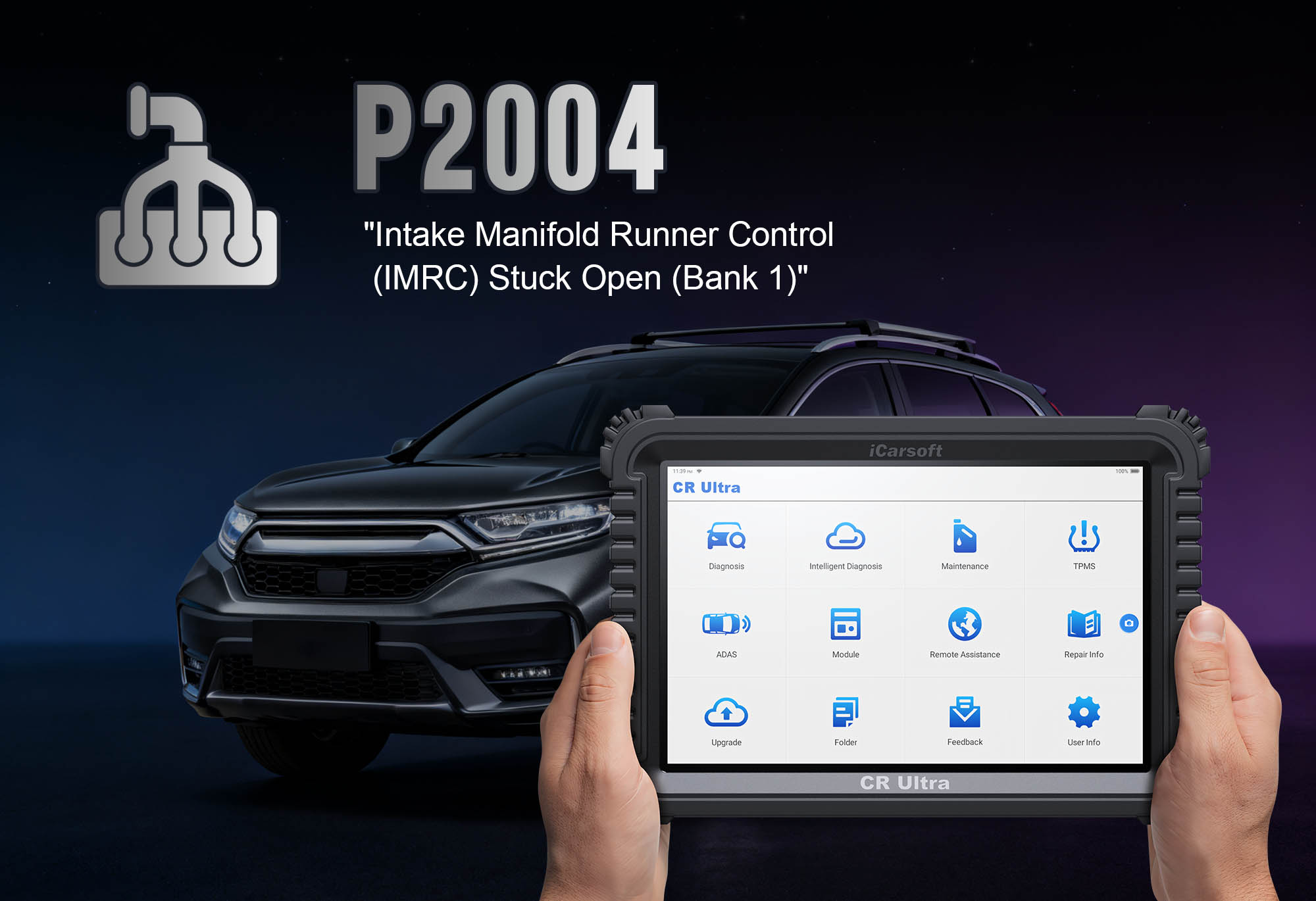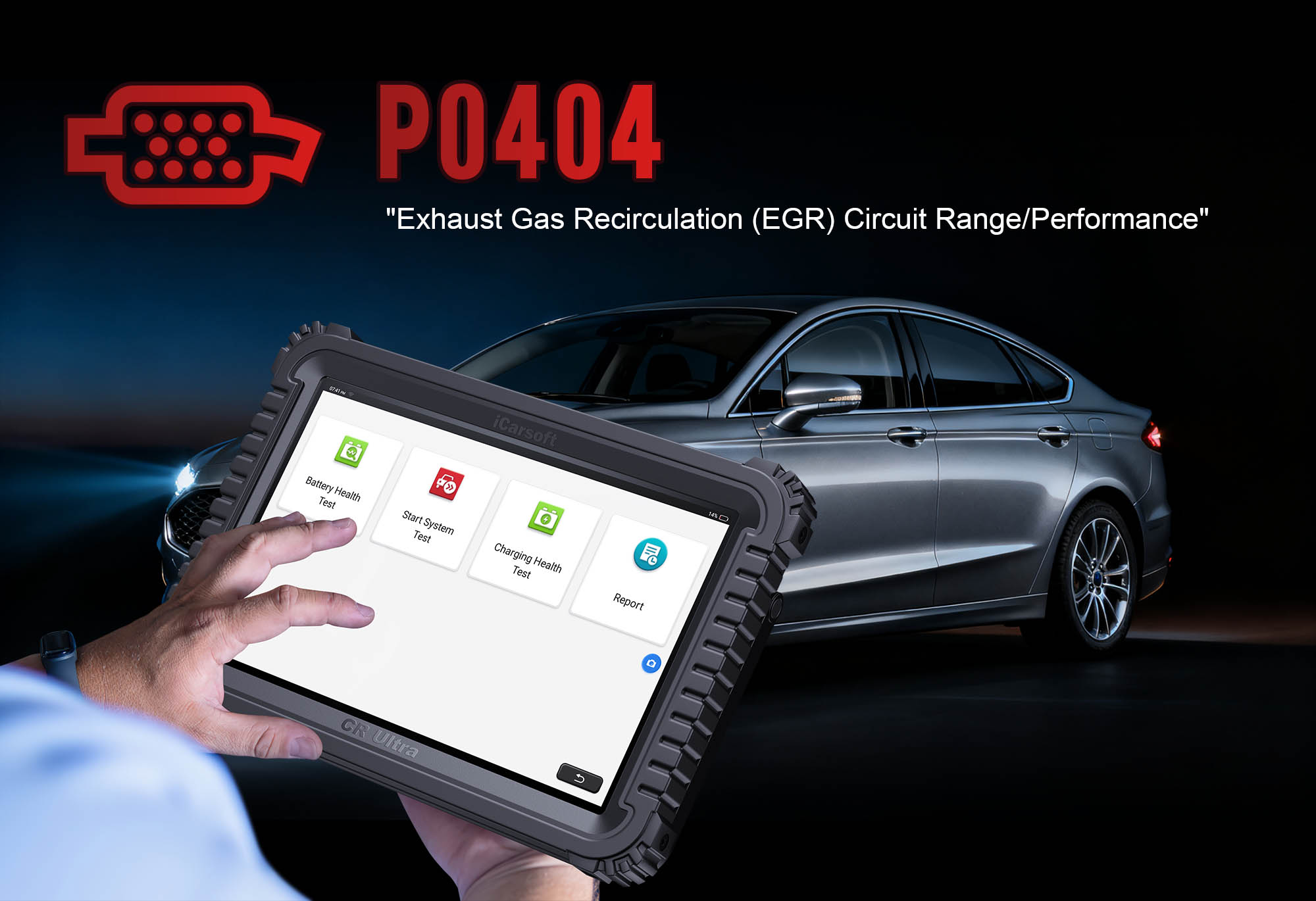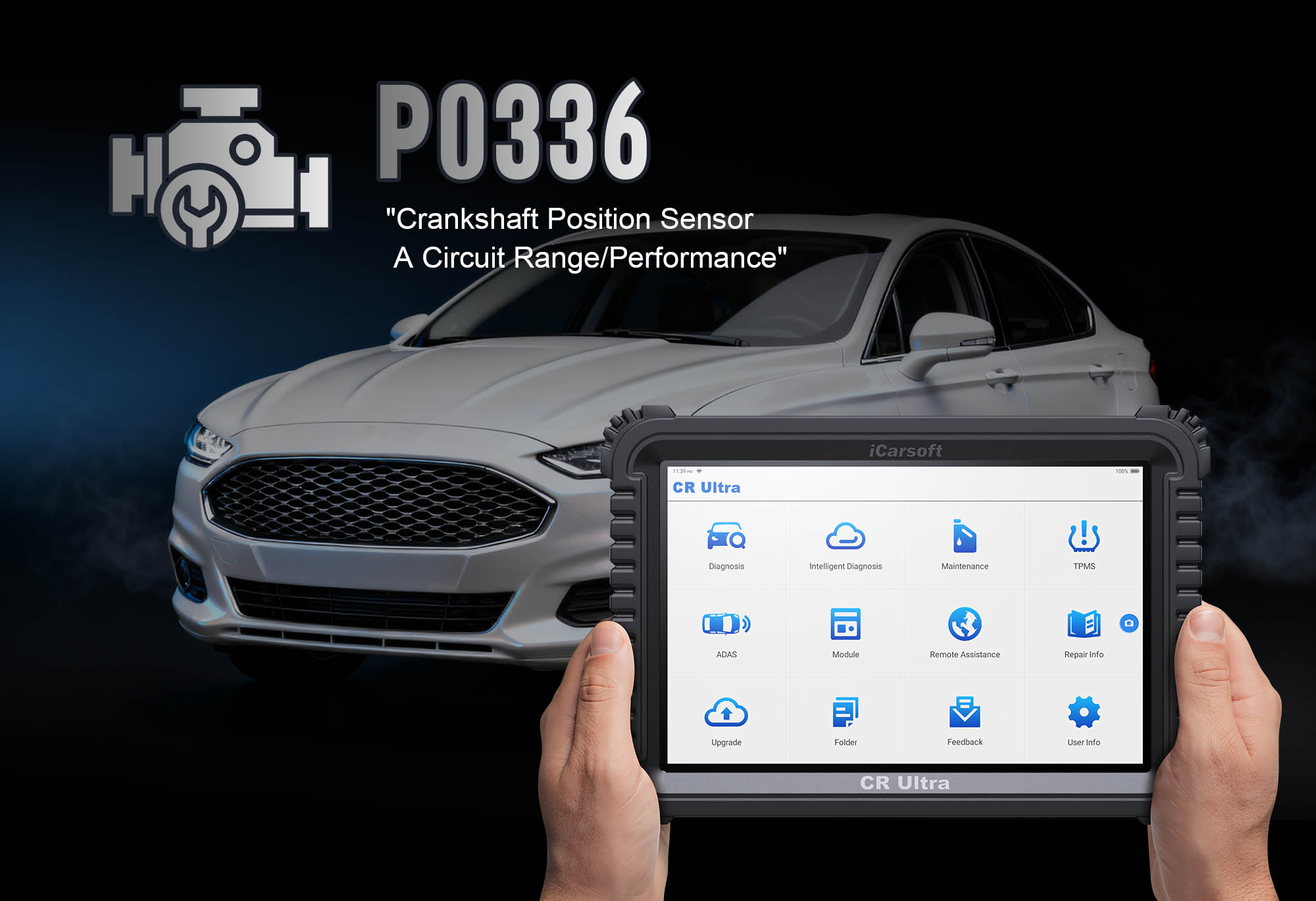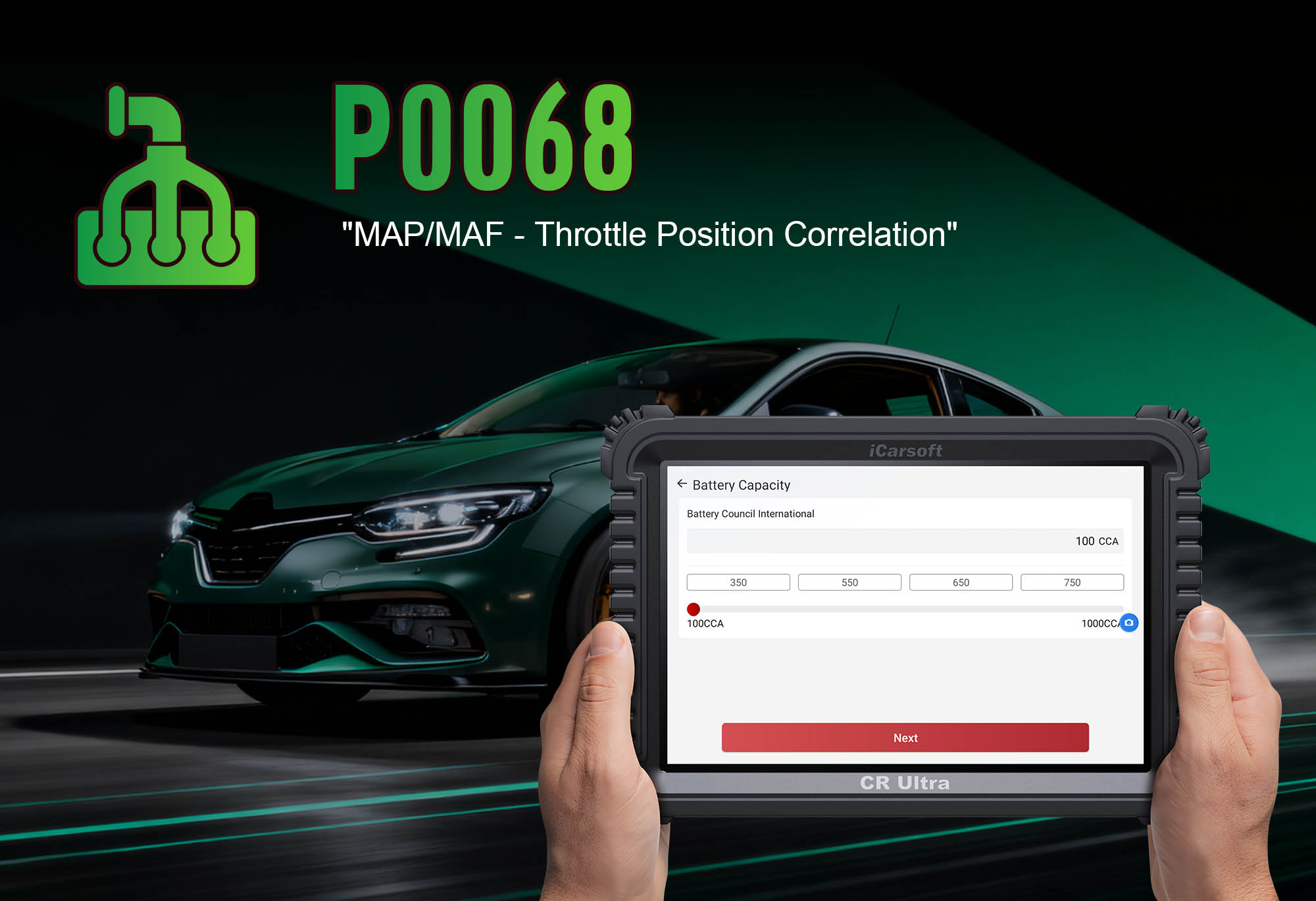Diagnose & Clear P2004 with iCarsoft CR Ultra: Fix Intake Manifold Runner Control Stuck Open (Bank 1)
If your check engine light illuminates and you notice reduced low-end torque, hesitation during acceleration, or increased fuel consumption, a diagnostic scan will likely return P2004. This OBD-II code stands for "Intake Manifold Runner Control (IMRC) Stuck Open (Bank 1)," indicating the Engine Control Module (ECM) has detected that the intake manifold runner valve on Bank 1 remains open when it should close—disrupting airflow optimization for engine load and RPM.
Intake manifold runners are adjustable passages that vary airflow into the cylinders based on engine speed: shorter runners enhance high-RPM performance, while longer runners boost low-end torque. The IMRC system uses solenoids or motors to open/close these runners, and a stuck-open valve on Bank 1 (cylinder bank containing cylinder 1) prevents proper airflow tuning. Left unaddressed, P2004 can reduce fuel efficiency by 10–15% and cause uneven wear on engine components.
Basic scanners may only flag "IMRC stuck open" but can’t test valve operation or isolate mechanical jams. The iCarsoft CR Ultra—with its bi-directional actuator control, pressure testing, and 3D component mapping—solves this. Let’s explore how to diagnose and resolve P2004 using this advanced OE-level tool.
 iCarsoft CR Ultra: Bi-directional control and 3D mapping for resolving P2004 (Intake Manifold Runner Control Stuck Open)
iCarsoft CR Ultra: Bi-directional control and 3D mapping for resolving P2004 (Intake Manifold Runner Control Stuck Open)
Understanding P2004: Causes & Key Symptoms
A stuck-open IMRC valve on Bank 1 disrupts airflow dynamics, leading to distinct performance issues:
Key Symptoms of P2004
-
Check Engine Light: Illuminates when the ECM detects the IMRC valve fails to close within 2–5 seconds of command (varies by manufacturer).
-
Reduced Low-End Torque: Without longer runner activation, the engine struggles with acceleration from a stop or at low RPM (e.g., climbing hills in a high gear).
-
Hesitation at Low Speeds: Uneven airflow causes hesitation when pressing the gas pedal at 1,500–2,500 RPM.
-
Increased Fuel Consumption: A disorganized air-fuel mixture forces the ECM to enrich fuel delivery, lowering MPG.
-
Rough Idle (Mild): Bank 1 cylinders may receive inconsistent airflow, causing slight idle vibrations.
-
Limp Mode (Severe Cases): Prolonged valve failure can trigger reduced power to protect the engine from damage.
Common Causes of P2004
-
Carbon Buildup: Oil vapors and fuel residues coat the IMRC valve or runner passages, preventing closure.
-
Faulty IMRC Solenoid or Motor: Electrical failure in the actuator prevents it from receiving/executing the ECM’s close command.
-
Broken Linkage or Stuck Valve: Mechanical damage (e.g., a snapped spring or bent lever) jams the valve in the open position.
-
Damaged Wiring or Connector: Corroded terminals, frayed wires, or loose plugs in the IMRC circuit disrupt communication with the ECM.
-
Intake Manifold Leaks: Vacuum leaks near Bank 1 alter pressure signals, confusing the ECM’s IMRC control logic.
-
ECM Software Glitch: Outdated or corrupted ECM calibration may send incorrect commands to the IMRC system (rare but fixable with updates).
Why iCarsoft CR Ultra Excels at Diagnosing P2004
The CR Ultra outperforms basic tools with OE-level features tailored to intake system diagnostics:
Bi-Directional IMRC Control
Sends direct commands to open/close the Bank 1 IMRC valve, verifying if it responds to ECM signals (e.g., "Valve fails to close when commanded—confirms mechanical or electrical fault").
Intake Pressure Testing
Measures manifold pressure before/after IMRC activation to identify stuck valves (e.g., "No pressure change during closure attempt—valve jammed").
3D Component Mapping
Displays high-resolution diagrams of the intake manifold, IMRC valve, solenoid, and linkage for 200+ vehicle brands, simplifying physical inspection.
Live IMRC Position Tracking
Monitors the valve’s actual position vs. the ECM’s target position, highlighting discrepancies (e.g., "Target: Closed, Actual: Open – 100% Stuck").
Carbon Buildup Detection
Integrates with smoke testing to identify restricted passages causing valve stickiness.
ECM Calibration Checks
Verifies software version compatibility and flags outdated firmware that may miscontrol the IMRC system.
Step-by-Step: Diagnose P2004 with iCarsoft CR Ultra
1. Connect & Confirm the Code
Plug the CR Ultra into your vehicle’s OBD-II port (use included adaptors for older models). Power on the tool and select your vehicle via Auto VIN Scan (instant VIN reading) or manual entry (make/model/year/engine).
-
Navigate to Engine > Fault Codes > Read Codes to confirm P2004. Tap Code Details for vehicle-specific insights (e.g., "Ford: IMRC Bank 1 Valve Stuck Open; Check Solenoid & Linkage").
2. Locate the Bank 1 IMRC Components
Use the CR Ultra’s 3D mapping to avoid confusion:
-
Go to Component Location > Engine > Intake System > IMRC (Bank 1).
-
The tool displays a 3D diagram highlighting:
-
IMRC Valve: Located inside the intake manifold on Bank 1 (cylinder bank with cylinder 1).
-
Solenoid/Motor: Externally mounted actuator controlling the valve (often attached to the manifold).
-
Linkage: Mechanical arms connecting the actuator to the valve.
-
Wiring Harness: Connections between the solenoid and ECM.
3. Test IMRC Valve Operation with Bi-Directional Control
A non-responsive valve is the top cause of P2004—verify with the CR Ultra:
Valve Activation Test:
-
Ensure the engine is off. Navigate to Special Functions > Engine > Intake Tests > IMRC Control.
-
Select "Bank 1" and command "Close." Listen for actuator movement (clicking or whirring) and use the tool’s Live Data > IMRC Position to monitor:
-
Target Position: Should read "Closed" (0% open).
-
Actual Position: Stays "Open" (100% open) = confirms P2004.
Pressure Change Verification:
-
With the engine running at 1,500 RPM, run the Intake Pressure Test (under "Special Functions"). A stuck valve shows no pressure increase when closed—normal operation increases pressure by 5–10 psi.
4. Inspect for Carbon Buildup & Mechanical Issues
Physical blockages often jam the IMRC valve—check with guidance from the CR Ultra:
Carbon Buildup Check:
-
Follow the tool’s Service Guide to remove the intake manifold (if necessary) or access the IMRC valve. Look for:
-
Black, sooty deposits on the valve seat or runner passages (common in direct-injection engines).
-
Oil residue (sign of a failing PCV system, which accelerates buildup).
Linkage & Valve Inspection:
-
Check for:
-
Broken springs or bent levers preventing valve closure.
-
Debris (e.g., small rocks or dirt) lodged in the valve mechanism.
-
Excessive play in linkage joints (causes delayed response).
5. Test IMRC Solenoid & Circuit Integrity
Electrical faults prevent proper valve control—diagnose with the CR Ultra:
Solenoid Resistance Test:
-
Disconnect the IMRC solenoid connector. Use the tool’s Multimeter Function to measure resistance. Normal = 10–30 ohms (varies by manufacturer). 0 or infinite ohms = faulty solenoid.
Circuit Voltage Test:
-
Turn the ignition to "On" (engine off). Measure voltage at the solenoid’s power pin (use the CR Ultra’s pinout guide). Normal = 12V. 0V = blown fuse or broken power wire.
Ground Circuit Check:
-
Measure resistance between the solenoid’s ground pin and the vehicle chassis. Normal = <1 ohm. High resistance = corroded ground—clean or repair.
6. Check for Intake Leaks & ECM Calibration
Secondary issues worsen P2004—verify with the CR Ultra:
Intake Leak Detection:
-
Navigate to Special Functions > Engine > Intake System > Smoke Test. Introduce smoke into the manifold; leaks near Bank 1 IMRC valves appear as smoke escaping from cracks or loose gaskets.
ECM Software Check:
-
Go to Diagnosis > Engine > ECM/PCM > Software Version. Compare with the latest OE update (via the CR Ultra’s Update Database). Outdated software = update using the tool’s ECM Reprogramming feature (if supported).
7. Repair & Clear P2004
Fix the Root Cause:
-
Clean carbon deposits from the IMRC valve and runners using specialized intake cleaner (follow the CR Ultra’s Cleaning Guide).
-
Replace a faulty solenoid, broken linkage, or jammed valve (use OEM parts—check the tool’s Part Lookup).
-
Repair wiring faults: Replace frayed wires, clean corroded connectors, or replace a blown fuse.
-
Update ECM software via the CR Ultra to resolve calibration issues.
Clear the Code: In the tool, go to Engine > Fault Codes > Clear Codes to delete P2004.
8. Validate the Repair
Confirm the IMRC system functions correctly:
-
Recheck with bi-directional control—valve should now close fully when commanded.
-
Test drive, focusing on low-speed acceleration and idle stability. Improved torque and responsiveness = successful repair.
-
Monitor live data during driving: IMRC position should adjust smoothly with RPM changes.
-
Re-scan with the CR Ultra: No P2004 recurrence = issue resolved.
Preventing P2004 Recurrence
The CR Ultra helps maintain reliable IMRC performance long-term:
-
Intake System Maintenance: Use the tool’s Service Reminder to clean intake manifolds and IMRC valves every 60,000 miles (more often for turbocharged engines).
-
PCV System Checks: Include PCV valve inspection in annual tune-ups to prevent oil contamination of intake components.
-
Software Updates: Regularly check for ECM updates via the CR Ultra’s Update Manager to ensure optimal IMRC control.
-
Regular Scans: Use the tool’s Quick Scan quarterly to monitor IMRC position and intake pressure, catching issues before they trigger P2004.
Conclusion
P2004’s stuck-open IMRC valve disrupts critical airflow tuning, but the iCarsoft CR Ultra simplifies diagnosis with bi-directional control, pressure testing, and 3D mapping. Whether cleaning carbon deposits, replacing a solenoid, or updating ECM software, this OE-level tool ensures you resolve the root cause—restoring low-end torque, fuel efficiency, and engine smoothness.
With the CR Ultra, tackling "intake manifold runner control" faults becomes a precise process, keeping your engine’s airflow optimized for every driving condition.

 iCarsoft CR Ultra: Bi-directional control and 3D mapping for resolving P2004 (Intake Manifold Runner Control Stuck Open)
iCarsoft CR Ultra: Bi-directional control and 3D mapping for resolving P2004 (Intake Manifold Runner Control Stuck Open)



